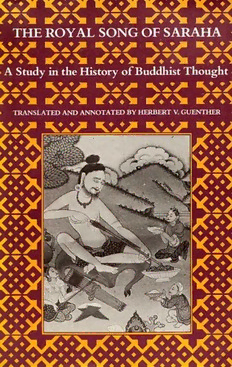
Royal Song of Saraha: Study in the History of Buddhist Thought PDF
Preview Royal Song of Saraha: Study in the History of Buddhist Thought
Saraha, arrowsmith, songster, and sage THE ROYAL SONG OF SARAHA A Study in the History of Buddhist Thought TRANSLATED AND ANNOTATED BY HERBERT V. GUENTHER $ ... ,,.,,,. ,~ SHAMBALA Berkeley and London SHAMBALA PUBLICATIONS, INC. 1409 Fifth Street Berkeley, California 94710 and Barn Cottage, Stert Devizes, Wiltshire Distributed in the Commonwealth and Europe by Routledge & Kegan Paul Ltd. London and Henley-on-Thames First paperback edition 1973 Copyright © 1968 by the University of Washington Press Printed in the United States of America Library of Congress 68-8512 ISBN 0-87773-042-3 Preface The richness ofE astern thought and its influence in moulding the life of the peoples in the Far East are still relatively little known and appreciated. The vast field of Tibetan thought and civilization is virtually unexplored. Too often, also, thought and action have been presented as unrelated to each other. The theme of this study of Saraha is the interrelation between thought and action. It is not exhaustive, rather ex ploratory, and attempts to show the significance of Saraha's work for the development ofTibetan Buddhist thought and ways oflife in the manner in which it was understood by the Tibetans themselves, as illustrated by the two commentaries translated here, one by the Nepalese scholar, sKye-med bde chen (eleventh century), and the other by the famous bKa' brgyud-pa Lama Karma Phrin-las-pa (fifteenth century). In this respect, it is hoped, this study will destroy the long cherished myth that the Tibetans merely translated mechani cally from Indian sources and thus were little more than the custodians of works unfortunately lost in India. There is nothing to support this myth and it is about time to realize that Indian Buddhist thought acted merely as a powerful stimulus to an otherwise profound indigenous thinking which could absorb and remodel new ideas. v In searching for expressions suitable for conveying the meaning of the many technical terms, I have tried to remain as close as possible to the associations these terms evoke in spoken Tibetan and to the ideas they convey to the Tibetan listener. It should be constantly borne in mind that in the field of philosophical thinking the Tibetans made use of symbolic etymologies distinct from the linguistic ones. In attempting to convey what the Tibetans understood and what they lived by, it is best to follow their example. Therefore, the transla tion offered here is not a "crib" which, pretending to deal with ideas, actually confuses irrelevant linguistic etymologies with significant philosophical statements. Eastern philo sophical texts, which in most cases are also psychologically informative, must be dealt with from the viewpoint of philosophy and psychology, not from that of exercises in grammar and syntax. No one can know better than I do that such a task is beset with difficulties, so much more so because philosophy is not something reducible to one or another" ism," but a perpetual questioning. I am not thinking of this translation as a substi tute for the original, because a translation worth the name is more a commentary on the original than a cheap substitute for it. Therefore, my aim has qeen not to give a complete and unchallengeable answer to any problem that arises in the texts, which would be impossible, but to give pointers in what I believe to be the right direction and to arouse interest, curiosity, and the desire to explore further. I wish to acknowledge my indebtedness and gratitude to Mr. K. Angrup, Lecturer at Panjab University, Chandighar, India, who assisted me in procuring the rare blockprint of Karma Phrin-las-pa's commentary on Saraha's Dohiis and in having it copied; to Geshe Nagwang Nima (dge-bshes Ngag-dbang Nyi-ma), formerly of Drepung monastery, Vl Tibet, and Research Fellow at the Sanskrit University in Varanasi, India, now at Kern Institute in Leiden, Holland; to Naynang Rinpoche (Gnas-nang dpa'- bo rin-po-che) of Darjeeling, India; and to the Incarnate Lama TarthangTulku (Dar-thang sprul-sku) at the Sanskrit University in Varanasi, for their untiring help in deciphering the often illegible blockprint and making the necessary corrections in the copied text. All of them were always ready to discuss and elucidate difficult passages. My thanks are also due to Professors L. Miller, T. Y. Henderson, and R. W. Krutzen of the University of Saskat chewan, who read part of the typescript and made valuable suggestions concerning the rendering ofp hilosophical terms. To G.J. Yorke, I owe much for style and presentation. I am especially grateful to the University of Saskatchewan for making available a substantial fmancial contribution for the publication of this book. My wife has given unstinted help in proofreading and indexing; and even more in the patience and understanding she has shown when all my spare time was devoted to the writing of this book. H. V. G. PREFACE Vll Contents PART I: TRADITION AND PHILOSOPHY The Tradition about Saraha and His Works 3 of The Teaching the Dohas 21 Existence versus Essence 42 PART II: THE ROYAL SONG OF SARAHA The Song on Human Action-the Treasure ·of Dohiis 63 PART III: COMMENT ARIES Commentaries by sKye-med bde-chen and Karma Phrin:..las-pa 75 Selected Bibliography 205 Index 209
